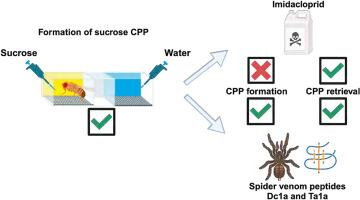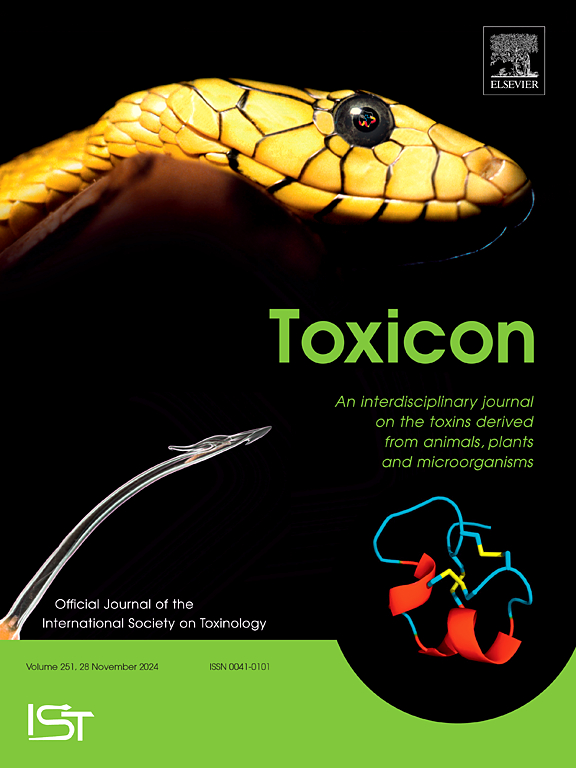利用果蝇条件性地点偏好试验研究杀虫化合物对情境记忆的影响。
IF 2.6
4区 医学
Q2 PHARMACOLOGY & PHARMACY
引用次数: 0
摘要
杀虫剂对保护农作物免受虫害至关重要,但许多杀虫剂对害虫种类缺乏选择性,而且生物降解性差。这导致有益生物(如授粉昆虫)成为杀虫剂的目标,并对土壤和水造成广泛的环境污染。接触新烟碱类杀虫剂会导致昆虫麻痹和死亡,而亚致死剂量则会破坏对生存至关重要的其他功能,如学习和记忆能力。目前正在探索将影响各种分子靶点的强效和选择性蛛形纲毒液肽作为候选生物杀虫剂。然而,人们对它们对昆虫学习的影响知之甚少。因此,我们利用黑腹果蝇建立了一种蔗糖诱导条件性位置偏好(CPP)试验,提供了一种评估各类杀虫化合物如何与昆虫记忆相互作用的方法,以评估其更广泛的生态后果。我们的研究结果证实,在调节阶段,每天注射亚致死剂量的新烟碱类杀虫剂吡虫啉(20 pg/只)会对果蝇CPP的形成产生不利影响。然而,在调节阶段之后施用吡虫啉并不影响 CPP 的回收。亚致死剂量的两种杀虫蜘蛛毒肽μ-DGTX-Dc1a(Dc1a;70 pg/只苍蝇)和U1-AGTX-Ta1a(Ta1a;125 pg/只苍蝇)对CPP的形成和回收都没有影响,这凸显了它们作为新型安全生物杀虫剂候选物的潜力。本文章由计算机程序翻译,如有差异,请以英文原文为准。

Using a conditioned place preference assay in fruit flies to examine effects of insecticidal compounds on contextual memory
Insecticides are vital for safeguarding agricultural crops against pests, albeit many lack selectivity towards pest species and are poorly bio-degradable. This leads to targeting of beneficial organisms like pollinators and widespread environmental contamination of soil and water. Exposure to insecticides such as neonicotinoids causes insect paralysis and mortality at higher doses, while sublethal doses can disrupt other functions that are crucial for survival such as learning and memory performance. Potent and selective arachnid venom peptides affecting a variety of molecular targets are being explored as bioinsecticide candidates. However, their effect on insect learning is poorly understood. We therefore established a sucrose-induced conditioned place preference (CPP) assay using Drosophila melanogaster fruit flies to provide a means of evaluating how various classes of insecticidal compounds interact with insect memory to assess their broader ecological consequences. Our results confirmed the adverse effect of a sublethal dose of the neonicotinoid insecticide imidacloprid (20 pg/fly) on fly CPP formation upon daily injection during the conditioning phase. However, imidacloprid did not affect CPP retrieval when applied after the conditioning phase. Sublethal doses of the two insecticidal spider venom peptides μ-DGTX-Dc1a (Dc1a; 70 pg/fly) and U1-AGTX-Ta1a (Ta1a; 125 pg/fly) had no effect on either CPP formation or retrieval, underlining their potential as novel and safe bioinsecticide candidates.
求助全文
通过发布文献求助,成功后即可免费获取论文全文。
去求助
来源期刊

Toxicon
医学-毒理学
CiteScore
4.80
自引率
10.70%
发文量
358
审稿时长
68 days
期刊介绍:
Toxicon has an open access mirror Toxicon: X, sharing the same aims and scope, editorial team, submission system and rigorous peer review. An introductory offer Toxicon: X - full waiver of the Open Access fee.
Toxicon''s "aims and scope" are to publish:
-articles containing the results of original research on problems related to toxins derived from animals, plants and microorganisms
-papers on novel findings related to the chemical, pharmacological, toxicological, and immunological properties of natural toxins
-molecular biological studies of toxins and other genes from poisonous and venomous organisms that advance understanding of the role or function of toxins
-clinical observations on poisoning and envenoming where a new therapeutic principle has been proposed or a decidedly superior clinical result has been obtained.
-material on the use of toxins as tools in studying biological processes and material on subjects related to venom and antivenom problems.
-articles on the translational application of toxins, for example as drugs and insecticides
-epidemiological studies on envenoming or poisoning, so long as they highlight a previously unrecognised medical problem or provide insight into the prevention or medical treatment of envenoming or poisoning. Retrospective surveys of hospital records, especially those lacking species identification, will not be considered for publication. Properly designed prospective community-based surveys are strongly encouraged.
-articles describing well-known activities of venoms, such as antibacterial, anticancer, and analgesic activities of arachnid venoms, without any attempt to define the mechanism of action or purify the active component, will not be considered for publication in Toxicon.
-review articles on problems related to toxinology.
To encourage the exchange of ideas, sections of the journal may be devoted to Short Communications, Letters to the Editor and activities of the affiliated societies.
 求助内容:
求助内容: 应助结果提醒方式:
应助结果提醒方式:


